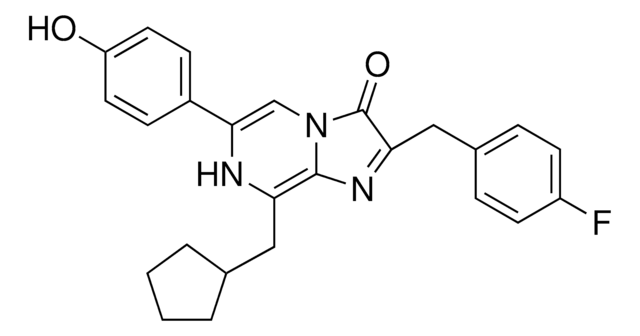233900
Coelenterazine
≥90% (TLC), solid, chemiluminescence probe of the superoxide anion, Calbiochem®
Synonym(s):
Coelenterazine, 2-( p-Hydroxybenzyl)-6-( p-hydroxyphenyl)-8-benzylimidazo[1,2-a]pyrazin-3-(7H)-one, 2-(p-Hydroxybenzyl)-6-(p-hydroxyphenyl)-8-benzylimidazo[1,2-a]pyrazin-3-(7H)-one
About This Item
Recommended Products
product name
Coelenterazine, A cell-permeable aequorin luminophore that acts as a very sensitive and specific chemiluminescence probe of the superoxide anion.
Quality Level
Assay
≥90% (TLC)
form
solid
manufacturer/tradename
Calbiochem®
storage condition
OK to freeze
protect from light
color
brown
solubility
methanol: 1 mg/mL
ethanol: soluble
shipped in
ambient
storage temp.
−20°C
InChI
1S/C26H21N3O3/c30-20-10-6-18(7-11-20)15-23-26(32)29-16-24(19-8-12-21(31)13-9-19)27-22(25(29)28-23)14-17-4-2-1-3-5-17/h1-13,16,27,30-31H,14-15H2
InChI key
YHIPILPTUVMWQT-UHFFFAOYSA-N
General description
Application
- to determine superoxide production
- to determine free radical production
- in cell suspension buffer for in vivo reconstitution of aequorin
Biochem/physiol Actions
Packaging
Warning
Legal Information
Storage Class Code
11 - Combustible Solids
WGK
WGK 3
Flash Point(F)
Not applicable
Flash Point(C)
Not applicable
Certificates of Analysis (COA)
Search for Certificates of Analysis (COA) by entering the products Lot/Batch Number. Lot and Batch Numbers can be found on a product’s label following the words ‘Lot’ or ‘Batch’.
Already Own This Product?
Find documentation for the products that you have recently purchased in the Document Library.
Our team of scientists has experience in all areas of research including Life Science, Material Science, Chemical Synthesis, Chromatography, Analytical and many others.
Contact Technical Service








